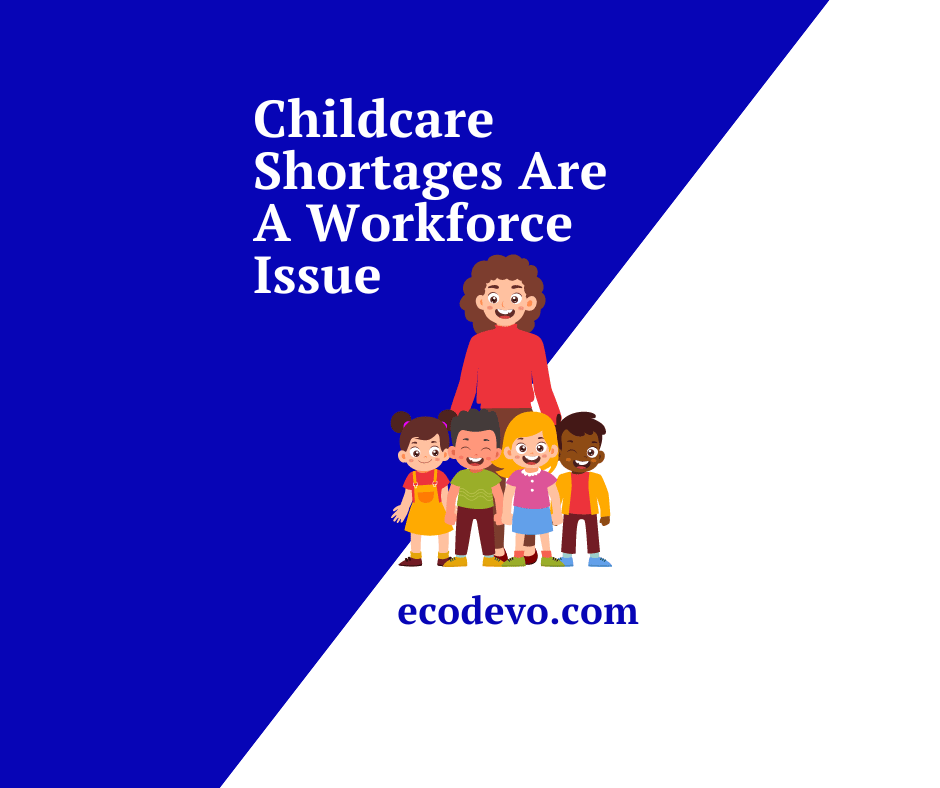
By: The Pottawatomie County Economic Development Corporation (PCEDC) | 10.5.24
The current childcare shortage in the United States is a multifaceted issue stemming from a combination of economic, social, and policy-related factors. Understanding these challenges requires an exploration of the various sources that have contributed to the problem, impacting both childcare providers and families seeking care. A prolonged shortage of child care also significantly affects the overall economy. As parents struggle to find care for their children, they may have to reduce their work hours or drop out of the workforce altogether.
1. Economic Pressures on Childcare Providers
One of the primary sources of the childcare shortage is the economic constraints faced by childcare providers. Operating a childcare facility is expensive, with significant costs associated with maintaining appropriate staffing levels, complying with safety regulations, and providing a nurturing environment for children. Childcare centers typically have low-profit margins due to the high costs of wages and benefits for staff, maintenance of facilities, and other operational expenses.
The COVID-19 pandemic exacerbated these financial challenges, forcing many childcare providers to close or limit their capacity due to health restrictions and reduced enrollment. Even as the pandemic has waned, the financial recovery has been slow, with many centers struggling to reopen or maintain their previous capacities. According to industry reports, the pandemic resulted in a significant reduction in the number of licensed childcare facilities, contributing to a severe shortfall in available slots for families.
2. Labor Shortages and Low Wages
A critical factor in the childcare shortage is the difficulty in retaining and attracting qualified childcare workers. The sector has long been plagued by low wages and limited benefits, making it hard to compete with other industries. Despite the demanding nature of the work, the average hourly wage for childcare workers is typically below that of jobs requiring similar skill levels, such as retail or hospitality positions.
The insufficient compensation not only undermines job satisfaction but also leads to high turnover rates. The instability in staffing creates further challenges for childcare centers, reducing the quality of care and making it harder to maintain consistent operations. Efforts to increase wages have been constrained by the already thin margins of childcare centers, creating a vicious cycle that perpetuates the labor shortage.
3. Regulatory and License Barriers
Regulatory requirements, while essential for ensuring the safety and well-being of children, can also be a barrier to expanding childcare capacity. States have stringent licensing standards regarding staff-to-child ratios, facility space, and safety regulations. While these regulations are necessary, they increase the cost of starting and running a childcare business, making it difficult for smaller providers to enter or stay in the market.
Additionally, the process for obtaining licenses and certifications can be complex and time-consuming, deterring potential new entrants. This regulatory burden, combined with the economic pressures, discourages innovation and expansion in the childcare sector, further limiting the availability of care.
4. High Cost of Care for Families
The high cost of childcare is a significant burden for many families, limiting their options and participation in the workforce. On average, families in the United States spend a considerable portion of their income on childcare, making it one of the highest household expenses alongside housing and food. For low- and middle-income families, the expense can be prohibitive, forcing parents, particularly women, to leave the workforce to provide care at home.
The lack of affordable childcare options has broader economic implications, as it reduces labor force participation and limits career advancement opportunities, especially for women. This has led to increased calls for greater public investment in childcare subsidies and support programs to alleviate the financial strain on families.
5. Lack of Public Investment and Support
Despite the recognized importance of early childhood education and care, public investment in the childcare sector has historically been low in the United States compared to other developed countries. This underinvestment has resulted in a fragmented and inadequately funded system that relies heavily on private funding from families.
Government programs provide some support, but the funding is insufficient to meet the growing demand. As a result, many families remain on waiting lists for subsidies, and providers struggle to offer care at an affordable rate. Calls for increased federal and state funding have gained momentum, but political disagreements and budgetary constraints have hindered comprehensive policy solutions.
6. Changing Demographics and Community Needs
Demographic shifts and changing family structures have also contributed to the childcare shortage. An increasing number of dual-income households and single-parent families has driven up the demand for childcare services. However, the supply of childcare slots has not kept pace, especially in rural and low-income urban areas where childcare deserts—areas with little to no access to childcare—are prevalent.
Additionally, as the workforce becomes more diverse and work hours become less traditional, the need for flexible, non-standard hour childcare has grown. Yet, most providers are not equipped to offer extended or irregular hours, leaving many families without suitable options.
7. Impact of the COVID-19 Pandemic
The pandemic had a profound impact on the childcare industry, accelerating many of the existing challenges. Temporary closures, reduced class sizes, and increased costs for cleaning and safety measures placed additional financial strain on providers. Many did not survive the pandemic, leading to a permanent reduction in the number of available childcare slots. For those that did remain open, the lingering effects of the pandemic, including labor shortages and increased operating costs, have made it difficult to return to pre-pandemic levels of service.
The childcare shortage in the United States is the result of a complex interplay of economic, regulatory, and social factors. Addressing this issue requires a multi-pronged approach that includes increasing public investment, supporting childcare workers through better wages and benefits, and streamlining regulatory processes to encourage the expansion of care options. Without significant intervention, the shortage will continue to place a heavy burden on families and impede broader economic growth.
Read More:
Intergenerational Childcare: The Heritage Home Case Study



